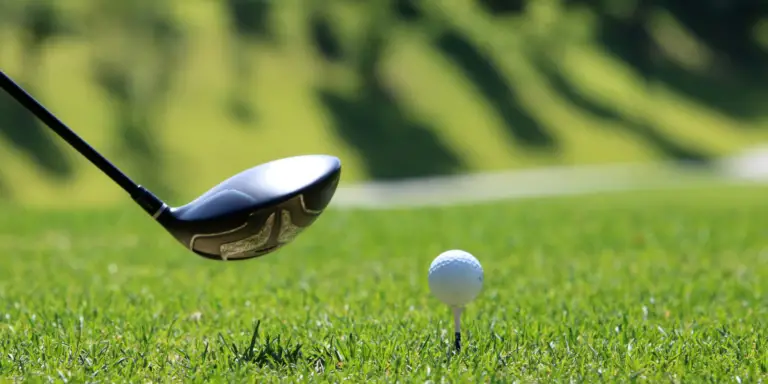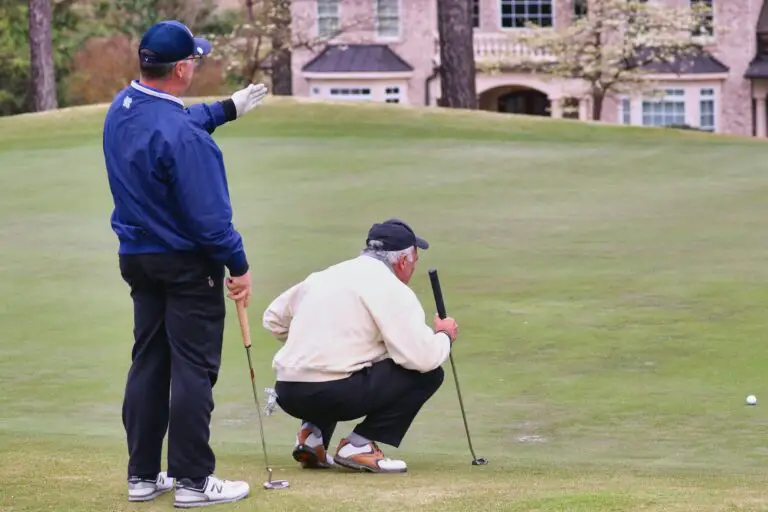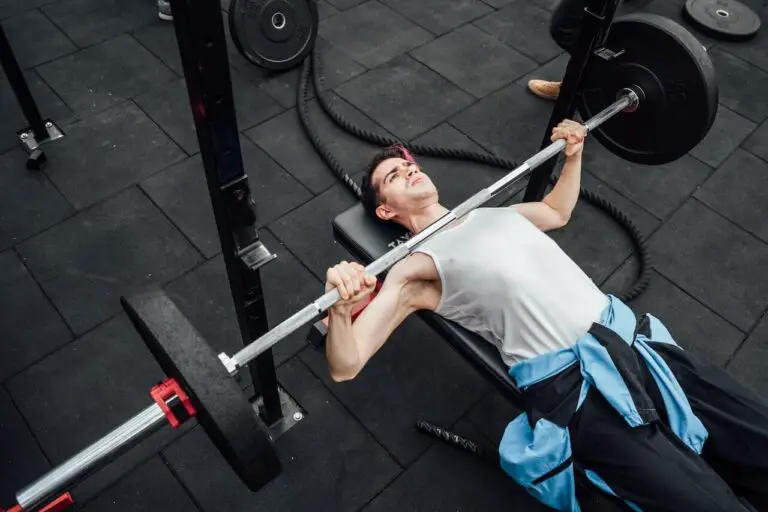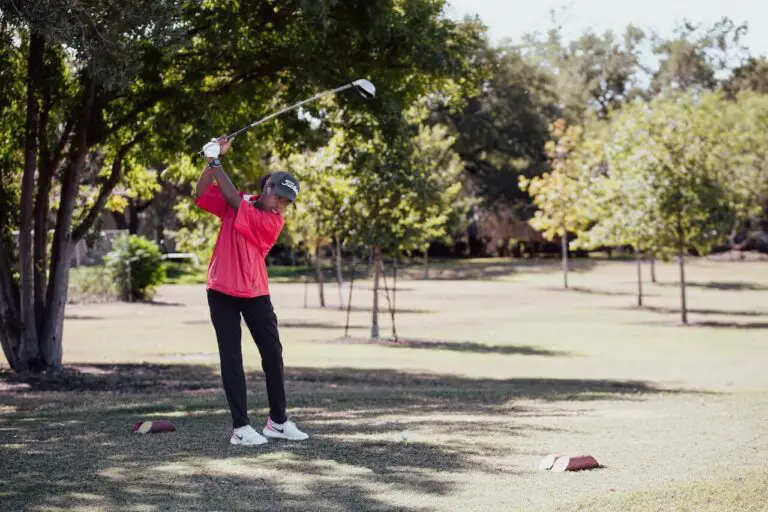How Far Should You Hit Your Golf Clubs?
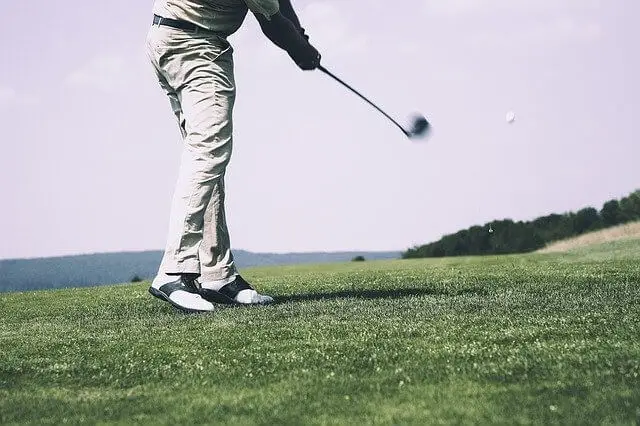
It’s a question that comes up quite regularly when talking about distance. Specifically, people ask how far should I hit my 7 iron, 3 wood, etc.
It’s by far the most important factor in achieving success on the course is understanding how far you hit each of your golf clubs. If you don’t know your distances, you’re just playing a game of guesses. Knowing the optimal distance for each club helps you make decisive shots and lower your score.
In this post, we’ll explore what affects golf club distances, how to know your yardages, recommended distances for different golf clubs, and tips for improving your golf club distance.
Factors That Affect Golf Club Distance
The main factors that determine how far your shots will go are:
- Clubhead speed: The faster the clubhead speed, the farther the ball will travel.
- Angle of attack: A steeper angle of attack will result in a lower trajectory and less distance.
- Spin rate: A high spin rate can cause the ball to lift and travel a shorter distance, while a low spin rate can cause the ball to travel farther.
- Ball compression: The compression of the ball refers to how much it is squished when it is hit.
- Club loft: The loft of a club refers to the angle of the clubface.
- Shaft flex: The flex of the shaft refers to how much it bends when the club is swung.
The two most influential factors in golf club distance are club head speed and loft. For example: Consider the loft of a Callaway Mavrik 7 iron at 27°, which is marketed as a super game improvement iron set. This is a much lower degree of loft when compared to the Mavrik Pro 7 iron at 30.5°.
Beginner or casual golfers have much slower swing speeds when compared to scratch golfers. This means that a scratch golfer can produce more distance from a 30.5° loft than an average golfer can produce with a 27° loft.
How to Measure Your Golf Club Distance
By measuring your golf club distances you can better understand how far each of your clubs goes. From there you can start to make adjustments to fine-tune your game. Here are a few ways to measure your golf club distances:
1. Use a golf launch monitor
A launch monitor is a device that measures the ball’s speed, spin rate, and trajectory as it leaves the clubface. This can give you an accurate measurement of your golf club distance.
2. Use a Golf GPS device
A GPS device can track the distance of your shots and give you an accurate measurement of your golf club distance.
3. Use a rangefinder
A rangefinder can help you dial in your distances with literal laser precision. These are a must-have on the range and the course and are the preferred option of all devices on the golf course.
4. Mark out a landing spot
If you do not have access to a launch monitor or GPS device, you can mark the landing spot of your shots and either walk off your distance, or use a measuring tape or rangefinder to measure the distance.
5. Keep track of your shots
Make notes of your shots and their distances so you can see patterns and trends in your distances for each club.
By measuring your golf club distance, you can identify which clubs you need to work on and make adjustments to your swing or club selection.
Recommended Distances For Different Golf Clubs & Skill Levels
Knowing the recommended distances for different golf clubs is crucial for making accurate shots and lowering your score. Here are some general guidelines for the distance you should be able to hit with each club:
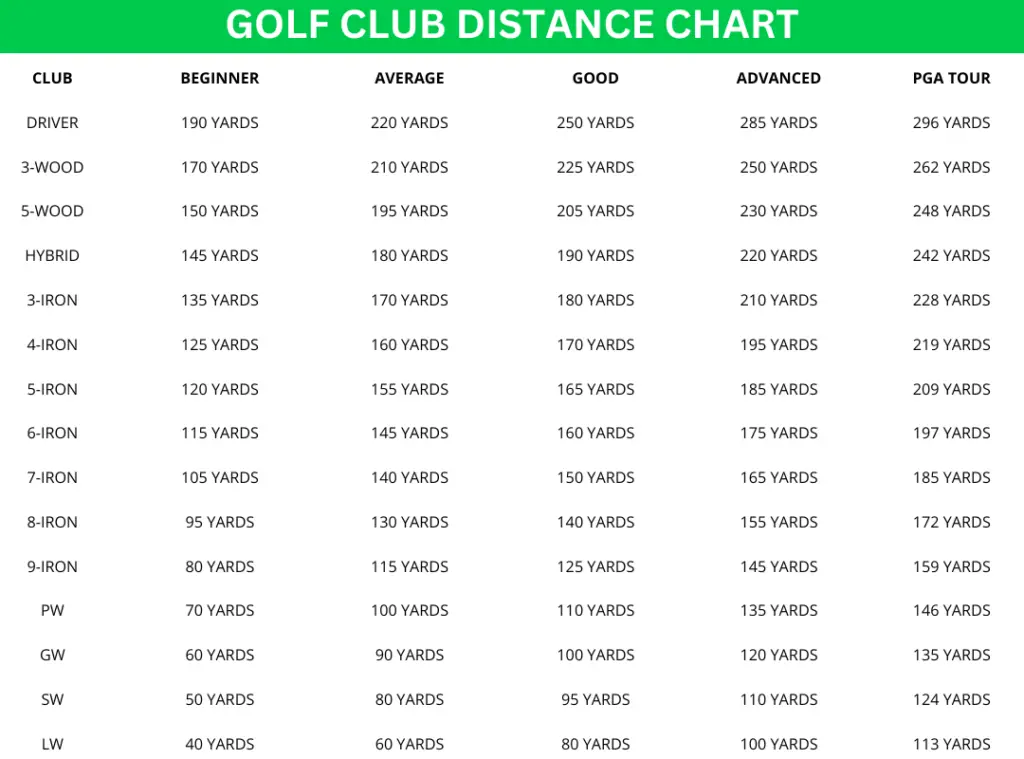
Recommended Yardages for Beginner Skill Level Golfers
| Club | Men | Women |
| Driver | 190 yards | 170 yards |
| 3-wood | 170 yards | 150 yards |
| 5-wood | 150 yards | 130 yards |
| Hybrid | 145 yards | 125 yard |
| 2-iron | 145 yards | 125 yards |
| 3-iron | 135 yards | 115 yards |
| 4-iron | 125 yards | 105 yards |
| 5-iron | 120 yards | 100 yards |
| 6-iron | 115 yards | 95 yards |
| 7-iron | 105 yards | 85 yards |
| 8-iron | 95 yards | 75 yards |
| 9-iron | 80 yards | 65 yards |
| Pitching Wedge | 70 yards | 60 yards |
| Gap Wedge | 60 yards | 50 yards |
| Sand Wedge | 55 yards | 40 yards |
| Lob Wedge | 40 yards | 35 yards |
Recommended Yardages for Average Skill Level Golfers
| Club | Men | Women |
| Driver | 220 yards | 190 yards |
| 3-wood | 210 yards | 170 yards |
| 5-wood | 195 yards | 160 yards |
| Hybrid | 180 yards | 160 yards |
| 2-iron | 180 yards | 155 yards |
| 3-iron | 170 yards | 150 yards |
| 4-iron | 160 yards | 140 yards |
| 5-iron | 155 yards | 135 yards |
| 6-iron | 145 yards | 125 yards |
| 7-iron | 140 yards | 120 yards |
| 8-iron | 130 yards | 110 yards |
| 9-iron | 115 yards | 95 yards |
| Pitching Wedge | 100 yards | 85 yards |
| Gap Wedge | 90 yards | 75 yards |
| Sand Wedge | 80 yards | 65 yards |
| Lob Wedge | 60 yards | 45 yards |
Recommended Yardages for Good Skill Level Golfers
| Club | Men | Women |
| Driver | 250 yards | 220 yards |
| 3-wood | 225 yards | 200 yards |
| 5-wood | 205 yards | 185 yards |
| Hybrid | 190 yards | 170 yards |
| 2-iron | 190 yards | 170 yards |
| 3-iron | 180 yards | 160 yards |
| 4-iron | 170 yards | 150 yards |
| 5-iron | 165 yards | 145 yards |
| 6-iron | 160 yards | 140 yards |
| 7-iron | 150 yards | 130 yards |
| 8-iron | 140 yards | 120 yards |
| 9-iron | 125 yards | 110 yards |
| Pitching Wedge | 110 yards | 100 yards |
| Gap Wedge | 100 yards | 90 yards |
| Sand Wedge | 95 yards | 80 yards |
| Lob Wedge | 80 yards | 60 yards |
Recommended Yardages for Advanced Skill Level Golfers
| Club | Men | Women |
| Driver | 285 yards | 250 yards |
| 3-wood | 250 yards | 225 yards |
| 5-wood | 230 yards | 205 yards |
| Hybrid | 220 yards | 190 yards |
| 2-iron | 210 yards | 190 yards |
| 3-iron | 210 yards | 180 yards |
| 4-iron | 195 yards | 170 yards |
| 5-iron | 185 yards | 160 yards |
| 6-iron | 175 yards | 150 yards |
| 7-iron | 165 yards | 140 yards |
| 8-iron | 155 yards | 130 yards |
| 9-iron | 145 yards | 120 yards |
| Pitching Wedge | 135 yards | 110 yards |
| Gap Wedge | 120 yards | 100 yards |
| Sand Wedge | 110 yards | 90 yards |
| Lob Wedge | 100 yards | 80 yards |
You can also see our other golf club distance charts for additional breakdowns on how far you should hit your golf clubs.
Tips for Improving Your Golf Club Distance
If you’re looking to improve your yardage with your clubs, there are a few key things you can do to increase your distance. Here are some tips:
1. Improve your swing mechanics
This is the foundation of your golf swing, and a proper swing technique will help you hit your ball farther. Focus on keeping your body in the right position, and make sure you’re using proper grip, stance, and alignment techniques to get the most out of your swing.
2. Generate more clubhead speed
The faster your clubhead is moving, the further your ball will go. I found that incorporating exercises that focus on upper body strength, such as pull-downs, squats and rotational exercises helped me get more clubhead speed.
3. Get better gear
Make sure you’re using clubs that are properly fitted for your swing and skill level and that have the correct flex and loft. I also recommend experimenting with different types of shaft flexes to find one that works best for your swing.
4. Play with the right golf ball
The right golf ball can make a big difference in your distance. I found that using a golf ball with low compression and designed specifically for distance helps me hit the ball farther.
5. Don’t skimp on your practice sessions
Practice regularly and focus on specific aspects of your swing that need improvement.
6. Get swing lessons/training
Sometimes, even with practice, we can’t see our own mistakes. A lesson from a professional can help you identify your faults and give you specific drills to try.
Wrap Up
Understanding how far you should hit each of your golf clubs is the most important factor for achieving success on the course. Above we have discussed what common factors that affect golf club distances, some methods to measure your own golf club distance, and some recommended distances for different golf clubs. We also shared some simple tips for improving your golf club distances. Note that improving your golf club distance takes time and practice, so be patient and don’t get discouraged if you don’t see immediate results.

